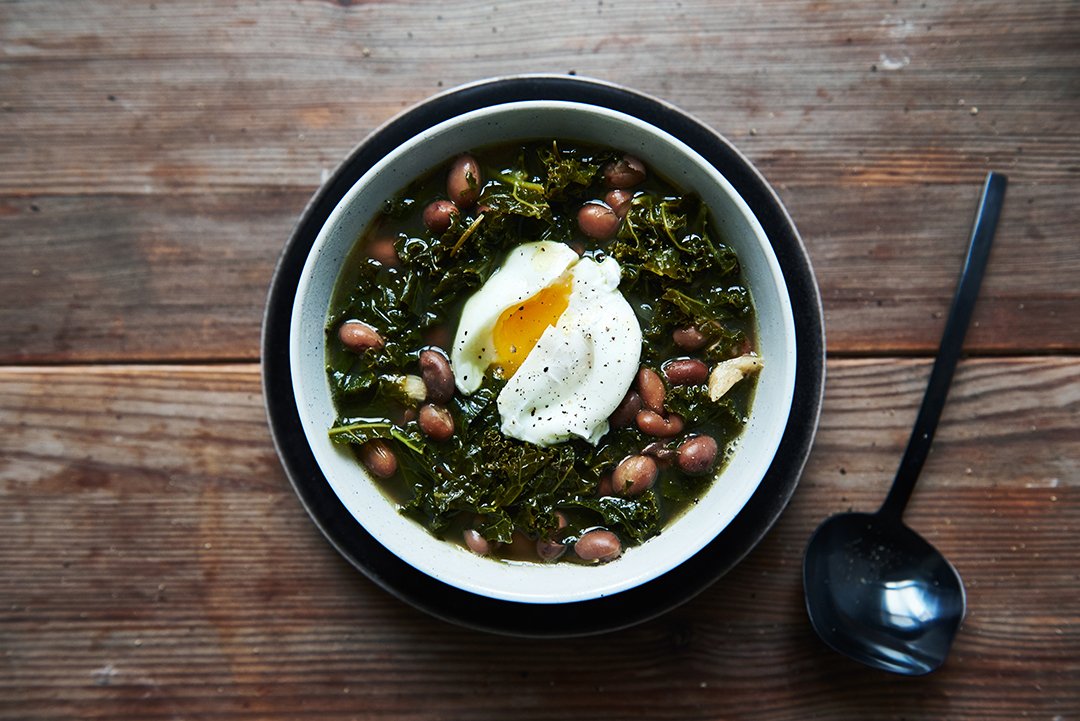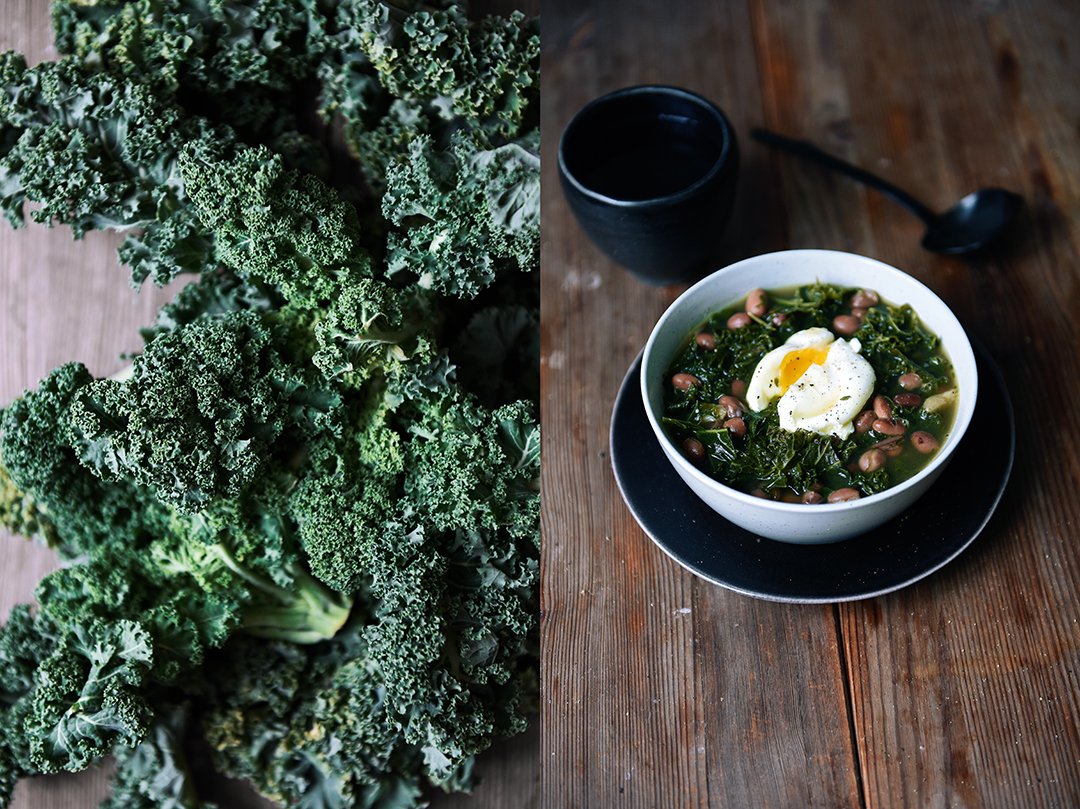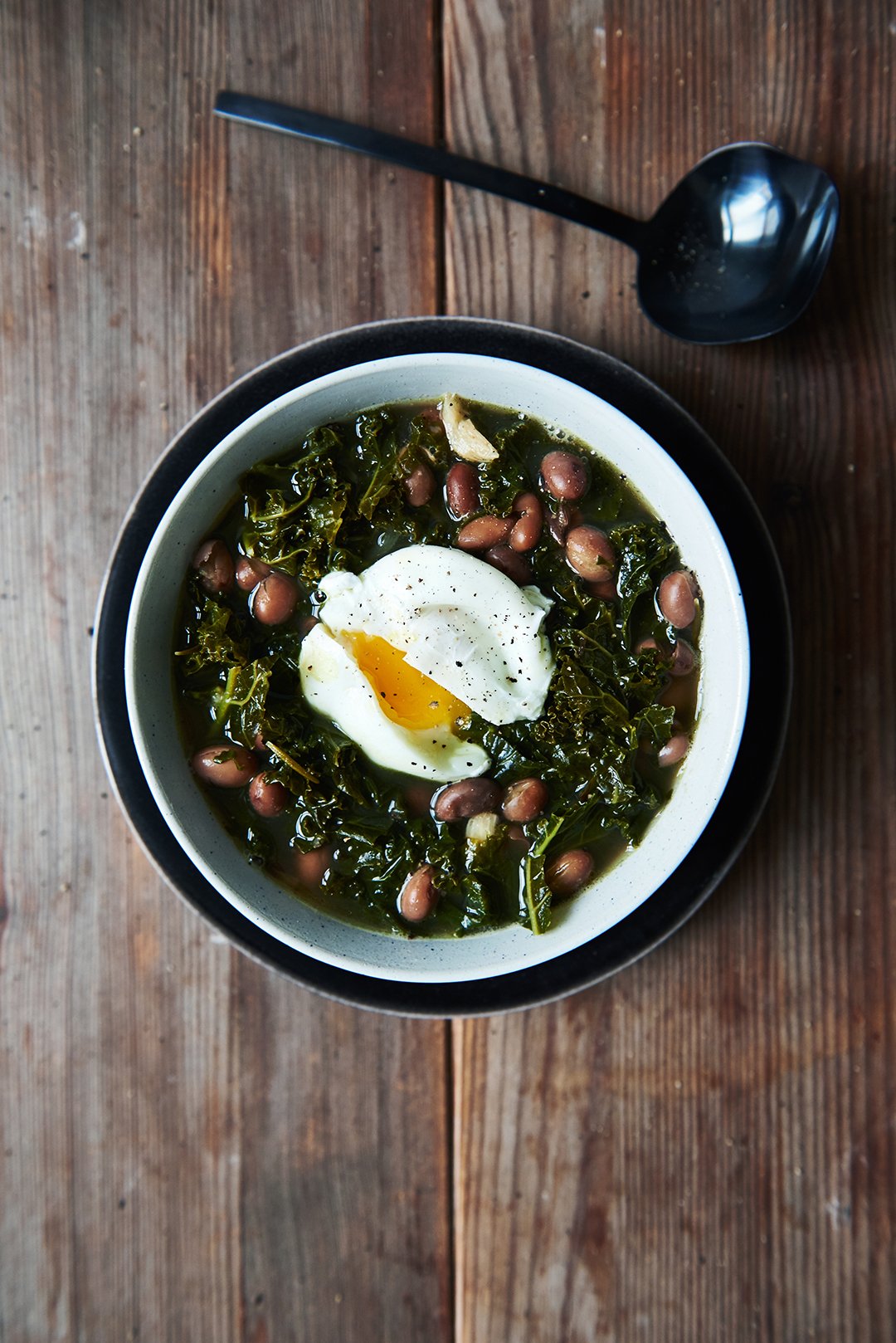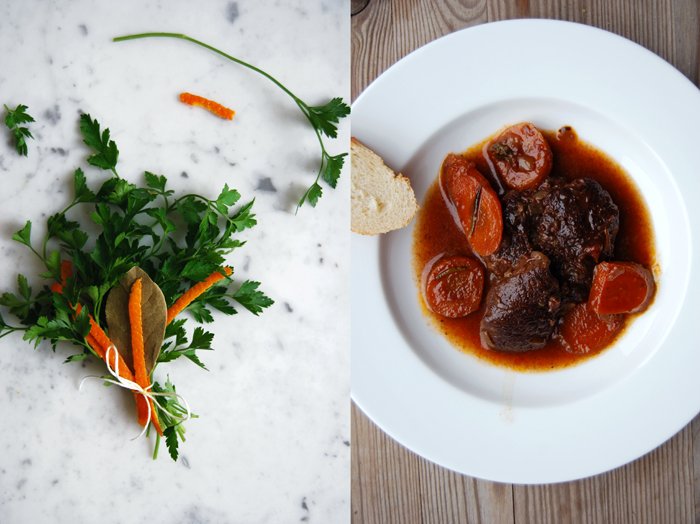Clean-Out-The-Fridge Soups
Food52 asked me about my approach to soups. Not just any soups, but big-flavor, clean-out-the-fridge soups to cure the winter blues. I love them now, but that wasn't always the case. We're like friends that had to learn to love each other. So I shared our bumpy love story, my basic soup formula, and three soup recipes from my new book, 365, on food52.com. Converted and convinced that a soup can be one of the best things to find on your dining table after a long day of work, I also decided to share my article on these pages here (and you can find two of the recipes from 365 below):
I have a new habit, recently, I often have soup for lunch, which is actually my breakfast as I only have green tea with lemon in the morning. My relationship with liquid foods wasn’t always so harmonic. Soups and stews are very popular in Germany, thick lentil, pea, or potato soup enriched with smoked sausage (Knackwurst or Knacker) is a German winter classic. As a child, I ate it, but I wasn’t particularly fond of it. There was something missing, or maybe I just wasn’t ready yet. Then the eighties came, the Nouvelle Cuisine reached home kitchens and all of a sudden soups where always puréed and as bright as candy: yellow squash, purple beet, squeaking green pea pod. Shallow bowls filled with colorful compositions, smooth and shiny, conquered the menus but unfortunately not my palate. Despite their vibrancy, they didn’t excite me. This is essential to me, and my taste buds - I want, I need food to excite me. So I took a break of many, many years until I found the kind of soup that I like.
Fast-forward to today and it has become a constant in my weekly culinary routine. My basic soup formula is very simple:
1. Canned legumes and dried lentils that don’t need to soak overnight. I always have a vast collection of cans filled with butter beans, cannellini, borlotti (cranberry) and kidney beans on my pantry shelves, and bags of black beluga lentils, dark green French Puy lentils, and yellow and red lentils. Legumes make a soup rich and wholesome, they add heartiness and a nutty touch. It's what turns a light soup into a proper meal.
2. Cleaning out the vegetable drawer. This drawer is a treasure box that needs to be emptied once in a while. Leafy vegetables, kale, chard, and spinach that start to wilt, sturdy roots like potatoes, parsnip, and beets that lie forgotten, the whole range of winter and summer squash, fresh beans, peas, and tomatoes. Every season has its produce that’s just waiting to crown a soup.
3. Using homemade or quality store-bought broth. My mother taught me to always cook my own broth, with leftover vegetables, chicken, duck, and beef bones, with fresh herbs and whole spices like allspice, peppercorns, and juniper berries. And a bay leaf, always a bay leaf. I then freeze it in 4-cup portions to have my tasty broth right at hand whenever I need it. I never use instant broth as I find it adds an artificial flavor. Broth is the base of a soup, it adds its taste to all the other ingredients and therefore deserves utmost attention.
Soups can easily follow the seasons and the cook’s mood. I want to throw them together spontaneously, quickly, without too much planning or overthinking. A quick look in the pantry and fridge and my mind starts playing. A soup is a simple, a frugal dish, but that doesn’t mean it can’t be exciting. Playing with flavors is a boundless game, playing with textures is at least as rewarding.And varying toppings allows the cook to serve a soup repeatedly without anyone noticing. Crunchy bacon cubes or dukkah, a dollop of velvety mascarpone or ricotta, a fried or poached egg, or a crumbled hardboiled egg, fried herbs like sage or rosemary, or roasted fruit like grapes, apple, pear, or apricot.
In my new book, 365: A Year of Everyday Cooking & Baking, I share a recipe for each day of the year, following the seasons and also the rhythm of the week, from Monday to Sunday, from quick and simple weekday dishes to luscious - and more time-consuming - roasts, stews, and cakes on the weekend. Soups are a constant treat in this rhythm, especially during the colder part of the year. There’s a cozy kale and borlotti bean soup for example, cooked in a flavorful duck broth (recipe from 365 below and on food52.com) - a clear vegetable broth works just as well - and it's the perfect cure for winter blues. It’s crowned with a poached egg and when you cut through the yolk and let it run into the broth, it adds a creaminess that’s even better than cream; as an added bonus: it only takes twenty minutes for dinner to be ready.
A golden squash, parsnip, and sweet potato soup - basically the tasty finds of a fridge clean out - could be kept chunky but with a nod to the good old Nouvelle Cuisine, I purée it and also go for a more extravagant topping that makes this recipe fit for a Christmas table. Red grapes roasted with woody rosemary until soft and shriveled, and a dollop of whipped orange mascarpone turn this dish into a festive stunner (recipe from 365 onfood52.com). However, crunchy bacon bites would make it even heartier and also quite appealing.
One of my favorite soups is the minestrone because there are no rules and limitations. Every vegetable, every combination that the cook finds fitting, works. For my green minestrone, I use green beans, peas (which I always have in my freezer), and zucchini, but that’s not set in stone, and add tiny meatballs refined with lime and arugula. It gives it a fresh citrusy note, similar to lemongrass. This is the speediest of all weekday soups. Once the meatballs are mixed and shaped, the entire soup and meat only need to cook for about 5 minutes (recipe below).
So what changed my mind, what made me fall in love with soups after so many years of skepticism? First, the taste, I had to find combinations that excite me, but then there’s something else. Sitting in front of a bowl of steaming soup is one of the coziest things I can think of. It makes me feel good while I eat it and this feeling stays. A soup is a friend of my mind and my body.
Kale and Borlotti Bean Soup with Poached Eggs
from ‘365 – A Year of Everyday Cooking & Baking’ (Prestel, 2019)
Serves 4
For the soup
Olive oil
1 medium onion, cut into quarters
2 large cloves garlic, cut in half
7 ounces (200 g) trimmed kale leaves, cut into strips
5¼ cups (1.25 liters) homemade or quality store-bought duck, chicken, or vegetable broth, hot
1 small bunch fresh thyme
1 medium sprig fresh rosemary
1 large bay leaf
Fine sea salt
Finely ground pepper
1¼ cups (250 g) drained and rinsed canned borlotti (cranberry) or pinto beans
For the topping
4 to 8 large eggs
Coarsely ground pepper
For the soup, in a large pot, heat a splash of olive oil over mediumheat and sauté the onion and garlic, stirring, for a few minutes or untilgolden and soft. Add the kale, stir, and cook for 1 minute then add the hotbroth, thyme, rosemary, and bay leaf. Season to taste with salt and finelyground pepper, reduce the heat, and simmer for 20 minutes or until the kale istender. Remove and discard the herbs then add the borlotti beans and cook for 1minute. Season to taste with salt and finely ground pepper and keep warm.
For the topping, bring a small saucepan of salted water to a low simmer.Crack 1 egg into a small bowl. Hold a large spoon just over the surface of thewater and gently pour the egg onto the spoon. Lower the spoon into the waterand hold until the egg white starts to turn white then use a tablespoon togently scoop the egg off the large spoon. Poach the egg for 3 minutes. Using aslotted ladle or spoon, transfer the egg to a plate. Poach the remaining eggsthe same way, adjusting the heat as needed to maintain a low simmer. It’s bestto poach 1 egg at a time, but you can cook 2 at once.
Divide the soup among bowls, place 1 to 2 eggs in the middle of each bowl, and sprinkle with a little coarsely ground pepper. Cut the tops of the eggs with a sharp knife and serve immediately.
Green Minestrone With Lime-Arugula Meatballs
from ‘365 – A Year of Everyday Cooking & Baking’ (Prestel, 2019)
Serves 2-4
14 ounces (400g) ground beef
2 large cloves garlic, crushed, plus 1 large clove garlic, cut in half
2 ounces ounces (60g) arugula leaves, finely chopped
1 teaspoon (heaping) freshly grated lime zest
Fine sea salt
Finely ground pepper
Extra-virgin olive oil
3/4 pound (340g) trimmed mixed green vegetables (such as green beans, frozen peas, zucchini, Brussels sprouts, broccoli, or kale, cut into bite-size pieces if necessary)
4 1/4 cups (1 liter) homemade or quality store-bought vegetable broth, hot
1 tablespoon freshly squeezed lime juice
1 bay leaf
1 spring onion (green part only), thinly sliced
Combine the ground beef, crushed garlic, arugula, lime zest, 1 teaspoon of salt, and a generous amount of pepper in a large bowl and mix with your hands until well combined. Form the mixture into 38 roughly 1-inch (2.5 cm) meatballs.
Heat a splash of olive oil in a large pot over medium heat. Add the garlic and sauté for 1 minute. Add a little more oil and the vegetables and sauté, stirring, for 1 minute. Add the hot vegetable broth, lime juice, and bay leaf, season to taste with salt and pepper, and bring to a boil. Add the meatballs then reduce the heat, cover, and simmer gently for 4 to 6 minutes or until the meatballs are just cooked through and the vegetables are tender. Season to taste with salt, pepper, and additional lime juice.
Divide the soup among deep bowls, sprinkle with the spring onion, and serve immediately.
Octopus Stifado, a Greek Stew with Octopus, Onions and Mint
A spontaneous decision took me to the island of Naxos in the Aegean sea on a warm early autumn evening a few years ago. My summer holidays had been cancelled due to my work and in late September I felt an urgent need for a break. I had never been to Greece before and when I saw the photos of this dry, quiet island and it's long and lonely beaches I knew that this was exactly what I had been looking for! Only a handful of the typical Greek houses in white and blue lined the coast, a picture of peace and seclusion. I'm a friend of quick decisions so in mid October I found myself on a ferry crossing the Aegean sea, passing all its beautiful small islands, Santorini, Ios, Irakleia and Paros before I reached the tiny harbour of Naxos in a golden sunset. I fell in love with this island there and then!
A bumpy path through a green valley dense with bamboo led me to my tiny hotel which turned out to be one of the most peaceful places I have ever been to. It was run by a lovely and caring couple from Athens who made me feel like I was part of the family. Most of the rooms were vacant at the time as it was well past the high season. My room was so close to the sea that I could here the soft waves reaching the shore all night, no city noise, no other hotels, no cars, just the sea and a lonely beach! In the morning I found out that I wasn't the only one enjoying this peaceful place on earth, as the sun rose on the horizon a sea turtle took her morning swim right in front of my hotel!
One night, the lady of the house asked me if I would like to join their dinner, she had made her traditional octopus stifado, a dark, rich stew with octopus and lots of red onions, garlic, tomatoes, red wine, bay leaves and vinegar. The octopus was unbelievably tender, the sauce thick and aromatic, I had to ask for the recipe! We had already enjoyed our dinner and sat together over a few glasses of wine when I wrote down a few notes as she didn't have a written recipe. It was a beautiful night, unforgettable, under the dark Aegean sky, nearly as black as my stifado!
Octopus Stifado
The octopus has to simmer softly on low temperature for 1 hour 45 minutes.
For 4 people you need
octopus, skinned and cleaned, 1.2kg / 2.5 pounds (around 2 octopus)
medium sized red onions, roughly chopped, 5
tinned tomatoes, 400g / 14 ounces
red wine 300ml / 10 ounces
garlic, peeled and quartered, 5 cloves
bay leaves 4
fresh mint leaves, roughly chopped, a small handful
salt and pepper
balsamic vinegar to taste
olive oil for frying
In a large pot, heat a splash of olive oil and fry the the onions on a medium heat for 5 minutes till soft. Add a little more oil and the whole octopus, turn the temperature down and fry for a few minutes. Add the other ingredients, close the lid and simmer on a low heat for 1 hour. After an hour, take off the lid and let the stew simmer for another 45 minutes on low temperature. Season with Balsamico vinegar, salt and pepper to taste and add the mint. Cut the head and tentacles into bite sized pieces and serve with either white bread or spaghetti.
This recipe makes a lot of sauce, we usually eat the octopus with bread on the side on the first day and the next day we enjoy the leftovers with pasta.
Daube de Boef Provençale, a most tender and aromatic Beef Stew
French food is on my mind! The creamy vichyssoise I wrote about yesterday put me in the mood for more treats from the French cuisine. I haven't had a stew in along time so that's first on my list. Meat braised for hours rewards your patience with the most tender and juicy meat. While it's simmering slowly (for nearly 6 hours in the case of my stew) on low temperature it soaks up all the wonderful flavours, the red wine, herbs and spices. You just put it in the oven, forget about it and take out the finished meal. I like to use beef shank for stews, gelatinous with a bit of fat, it guarantees a succulent result, not dry at all and so tender that you could easily cut it with a fork.
This stew is called a daube because in Southern France, it's traditionally made in a daubière, a clay pot with a round belly, a narrow neck and a lid with a well which is filled with water. The evaporating water causes the cooking liquids to condense inside the lid, simple physics but more importantly it makes a great stew! Unfortunately, I don't have a daubière but I found out that a casserole dish with a tight lid works just as well.
The wine, herbs and spices have a big impact on the quality and taste of a daube just as much as the right kind of meat and cooking dish. As much as I love recipes that focus on single strong flavours, I accept that a stew follows its own rule, more is more! I prepared two different bouquets garni, one with parsley, bay leaf and orange peel and the other with rosemary, sage and thyme, combining all the aromas ripening under the sun of the Provençe. My open spice box inspired me to throw in a few cloves, allspice and cinnamon as well, they mixed in perfectly with the meat's juices, the red wine, brandy, tomatoes, carrots and garlic.
I've praised the meat's tenderness already and the sauce impressed me just as much. It was so concentrated that I just had to dip a piece of baguette into the dark red juices to taste the whole spectrum of aromatic flavours united in this stew. A sip of my glass of French red wine made the Provençe experience complete!
Daube de Boef Provençale
You need a big casserole dish with a tight lid. The daube has to cook in the oven for nearly 6 hours.
For 4-5 people you need
beef shanks, with the bone, 4 slices (around 1.8kg / 4 pounds) (I didn't cut the meat into pieces, I braised the slices with the bone to keep it juicy)
carrots, sliced, 800g / 28 ounces
medium sized onions, chopped, 4
garlic, chopped, 4
brandy 150ml
strong red wine 1000ml
broth 400ml
canned tomatoes 800ml
cloves 8
allspice 14
cinnamon 1 stick
olive oil for frying
salt and pepper
For the 2 bouquets garni
bouquet garni no. 1
parsley, a small bunch
bay leaves 2
long strips of orange peel 8
Divide and bind with strings into 2 bouquets.
bouquet garni no. 2
thyme, a small bunch
rosemary 2 sprigs
sage leaves 8
Divide and bind with strings into 2 bouquets.
Set the oven to 180°C / 355°F top/ bottom heat.
In a large casserole dish, heat a splash of olive oil and fry the meat for a few seconds on both sides (in batches), season with salt and pepper and set aside. Add some more oil and fry the onions, garlic and carrots for a few minutes on medium heat. Deglaze with the brandy, add the meat and layer alternating with the vegetables, add the tomatoes, spices, broth and wine, the liquid should just cover everything. Season with salt and pepper and add the 4 bouquets garni.
Put the casserole dish in the oven. After 45 minutes, turn the temperature down to 140°C / 285°F and cook for 4-5 hours or until very tender.
When the meat is done, remove the bouquets garni and cinnamon stick and season the daube with salt and pepper to taste. Serve with baguette or cooked potatoes.
Labskaus, a Sailor's Feast
Whenever there was Labskaus on our table at lunch time, I was a happy child! It's a traditional Northern European dish, sailor's food with meat and vegetables stewed in broth, with a slightly sweet taste coming from gherkin, beetroot and potatoes.
It's one of these recipes that evolved through the years, each region or country created their own variation on Labskaus and added or changed a few ingredients. It's made with corned beef which is more common, sometimes with minced beef which I prefer. Some cities in the North of Germany, like Hamburg or Bremen, mix soused hering (Matjes in German) in, others have it on the side, or they add a fried egg like I do which is completely unacceptable for some. The beetroot causes the same controversy, I like it as it adds some sweetness and it creates a pretty colour. When it comes to the soused hering, I leave it out, it's not my thing. You can find Labskaus in many Scandinavian countries as well but generally without the fish.
When I have this hot stew on my plate I'm still as happy to enjoy it as I was as a child!
Labskaus
For 4 people you need
minced beef 600g / 21 ounces
potatoes, peeled, cut into cubes, 600g/ 21 ounces
beetroots, peeled, cut into cubes, 500g / 18 ounces
medium sized onions, chopped, 2
broth 1 liter
bay leaf 1
garlic, cut in half, 2 cloves
cloves 5
pickled gherkin, chopped, 6-10
liquid from the pickled gherkin 4 tablespoons plus more to taste
salt and pepper
olive oil for frying
organic eggs 4
butter for frying
In a large pot, heat some oil and fry the onions until golden and soft. Add some more oil and fry the minced beef for a few minutes until all the liquid has evaporated. Add the other ingredients (except the gherkin, their liquid and the eggs) and cook for an hour. Season with salt and pepper and add the gherkin and their liquid to taste.
Fry the eggs in a little butter, leaving the egg yolks soft, and put one of them on top of the Labskaus in each plate.



















